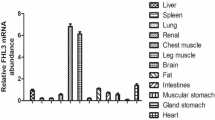Abstract
The Src homology 3 and cysteine-rich domain 3 gene (STAC3) encodes a protein containing both a cysteine-rich domain and two Src (sarcoma) homology 3 domains (SH3). STAC3 is specifically expressed in skeletal muscle and plays an important role in skeletal muscle development, but the explicit sequence and function of chicken SATC3 remain unknown. In the current study, we found the full-length chicken STAC3 cDNA to be 1383 bp long, with a 1092 bp open reading frame that harbors one cysteine-rich C1 domain and two SH3 domains. Tissue distribution analysis reveals chicken STAC3 mRNA only in skeletal muscle among 12 chicken tissues examined by reverse transcription PCR. Both cholecystokinin octapeptide analysis and a 5-ethynyl-2′-deoxyuridine assay suggest that neither STAC3 overexpression nor knockdown has any effect on the proliferation of chicken skeletal muscle satellite cells. However, STAC3 knockdown significantly increases the mRNA expression of MyoG, MyoD, Mb, and MyHC, and the protein abundance of MyHC and MyoG, whereas the opposite result is found in STAC3 overexpressed cells. We conclude that the STAC3 gene is expressed specifically in skeletal muscle and is a negative regulator of skeletal muscle satellite cell differentiation in chicken.






Similar content being viewed by others
References
Bismuth K, Relaix F (2010) Genetic regulation of skeletal muscle development. Exp Cell Res 316(18):3081–3086
Bower NI, Johnston IA (2010) Discovery and characterization of nutritionally regulated genes associated with muscle growth in Atlantic salmon. Physiol Genomics 42A(2):114
Bower NI, Dg DLS, Cole NJ, Hollway GE, Lee HT, Assinder S, Johnston IA (2012) Stac3 is required for myotube formation and myogenic differentiation in vertebrate skeletal muscle. J Biol Chem 287(52):43936
Carducci M, Perfetto L, Briganti L, Paoluzi S, Costa S, Zerweck J, Schutkowski M, Castagnoli L, Cesareni G (2012) The protein interaction network mediated by human SH3 domains. Biotechnol Adv 30(1):4–15
Emerson C (1990) Myogenesis and developmental control genes. Curr Opin Cell Biol 2(6):1065–1075
Ge X, Zhang Y, Park S, Cong X, Gerrard DE, Jiang H, Alway SE (2014) Stac3 inhibits myoblast differentiation into myotubes. PLoS ONE 9(4):e95926
Horstick EJ, Linsley JW, Dowling JJ, Hauser MA, McDonald KK, Ashley-Koch A, Saint-Amant L, Satish A, Cui WW, Zhou W (2013) Stac3 is a component of the excitation–contraction coupling machinery and mutated in Native American myopathy. Nat Commun 4:1952
Kawai J, Suzuki H, Hara A, Hirose K, Watanabe S (1998) Human and mouse chromosomal mapping of Stac, a neuron-specific protein with an SH3 domain. Genomics 47(1):140
Kurochkina N, Guha U (2013) SH3 domains: modules of protein–protein interactions. Biophys Rev 5(1):29–39
Legha W, Gaillard S, Gascon E, Malapert P, Hocine M, Alonso S, Moqrich A (2010) stac1 and stac2 genes define discrete and distinct subsets of dorsal root ganglia neurons. Gene Expr Patterns 10(7–8):368–375
Livak KJ, Schmittgen TD (2001) Analysis of relative gene expression data using real-time quantitative PCR and the 2−ΔΔCT method. Methods 25(4):402–408
Nelson BR, Wu F, Liu Y, Anderson DM, Mcanally J, Lin W, Cannon SC, Bassel-Duby R, Olson EN (2013) Skeletal muscle-specific T-tubule protein STAC3 mediates voltage-induced Ca2+ release and contractility. Proc Natl Acad Sci USA 110(29):11881
Pawson T (1994) SH2 and SH3 domains in signal transduction. Adv Cancer Res 64:87–110
Reinholt BM, Ge X, Cong X, Gerrard DE, Jiang H (2013) Stac3 is a novel regulator of skeletal muscle development in mice. PLoS ONE 8(4):e62760
Satoh J, Nanri Y, Yamamura T (2006) Rapid identification of 14-3-3-binding proteins by protein microarray analysis. J Neurosci Methods 152(1–2):278–288
Suzuki H, Kawai J, Taga C, Yaoi T, Hara A, Hirose K, Hayashizaki Y, Watanabe S (1996) Stac, a novel neuron-specific protein with cysteine-rich and SH3 domains. Biochem Biophys Res Commun 229(3):902
Tamura K, Stecher G, Peterson D, Filipski A, Kumar S (2013) MEGA6: molecular evolutionary genetics analysis version 6.0. Mol Biol Evolut 30(12):2725–2729
Zhang Y, Cong X, Wang A, Jiang H (2014) Identification of the STAC3 gene as a skeletal muscle-specifically expressed gene and a novel regulator of satellite cell differentiation in cattle. J Anim Sci 92(8):3284–3290
Acknowledgements
This research was supported by Natural Science Foundation of China (31402069), China Agriculture Research System (CARS-40-K06) and Sichuan Science and Technology Program (2016NYZ0050). We thank Steven M. Thompson, from Liwen Bianji, Edanz Editing China (https://www.liwenbianji.cn/ac), for editing the English text of a draft of this manuscript.
Author information
Authors and Affiliations
Contributions
HY, JZ, and QZ performed the conceptualization; HY and JZ performed the methodology; HY and DL performed formal analysis; HY, JZ, SH, and CC performed investigation; QZ provided resources; HY wrote original draft preparation; HY and QZ wrote review and editing; QZ provided supervision; YW provided project administration; QZ and HY provided funding acquisition.
Corresponding author
Ethics declarations
Conflict of interest
On behalf of all the authors, the corresponding author states that there is no conflict of interest.
Ethics statement
All animal studies were approved by the Committee on Experimental Animal Management of Sichuan Agricultural University. The permit number is 2016-0AT070.
Electronic supplementary material
Below is the link to the electronic supplementary material.
Rights and permissions
About this article
Cite this article
Yin, H., Zhao, J., Han, S. et al. Molecular characterization, tissue distribution, and functional analysis of the STAC3 gene in chicken. 3 Biotech 10, 171 (2020). https://doi.org/10.1007/s13205-020-2161-2
Received:
Accepted:
Published:
DOI: https://doi.org/10.1007/s13205-020-2161-2




